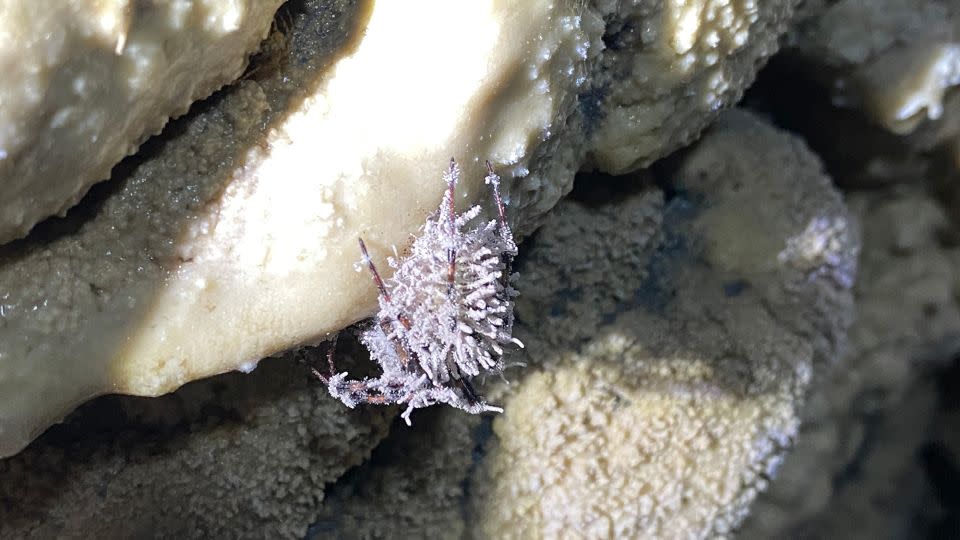Sign up for CNN’s Wonder Theory science newsletter. Explore the universe with news on fascinating discoveries, scientific advancements and more.
Scientists in Europe have identified a previously unknown species of fungus that turns cave spiders into “zombies.” The fungus lures them out of their webs before instigating an untimely death and then uses the spiders’ corpses to spread its spores.
The newly discovered species, named Gibellula attenboroughii, acts in a similar way as the zombie ant fungus, seemingly manipulating its prey to move to a more suitable spot for the fungus to spread, according to a study published January 24 in the journal Fungal Systematics and Evolution.
But the way in which the fungus affects the arachnid’s brain is still a mystery, and a multitude of questions remain about the fungus’ evolutionary pathway and ecological impacts.
“We know very well the ants, the wasps, and very few other examples. And now this is in a different family, so it’s a new origin of behavior manipulation,” said study coauthor Dr. João Araújo, a mycologist at the Natural History Museum of Denmark and an assistant professor at the University of Copenhagen. “It’s something really interesting that’s not super common in the parasitic world.”
The finding opens up new research opportunities to better understand animal-controlling fungus and illuminates the diversity of fungi yet to be uncovered, researchers said.

The fungus lures the spiders to an area more suitable to spread its spores, the study authors hypothesize. A spider is infected with G. attenboroughii at the stage of spore production. – Tim Fogg
Zombie spider fungus discovery
The newfound species is part of a larger branch of fungi that exclusively infects spiders.
Researchers observed a different species of Gibellula (G. aurea found in Brazil) possibly manipulating spiders to move to the underside of leaves before death, as described in a November 2022 study coauthored by Araújo. However, the maneuver was not as strikingly evident as it is when G. attenboroughii targets cave spiders, Araújo said.
So far, scientists have only observed G. attenboroughii infecting the spiders Metellina merianae and Meta menardi, both cave-dwelling orb weavers that are found in Europe.
The first sighting of the peculiar fungus has a colorful backstory: In 2021, a television crew first spotted the fungus on an orb weaver spider while filming a show in an abandoned gunpowder storeroom at Castle Espie Wetland Centre in Northern Ireland’s County Down.
The crew noticed that the spider placed itself in an exposed position before death, away from its web, suggesting the fungus had caused behavioral change.
Further observations revealed more infected spiders in caves in both Northern Ireland and Ireland, all positioned in exposed areas of the roof or walls of the chambers, according to the study.

The researchers observed several infected spiders on the cave roof and walls of Whitefathers’ Caves in Ireland. The fungus was also found in cave systems in Northern Ireland. – Tim Fogg
“Most spiders that are web-building spiders very much like to stay on their web. They’re built to be good inside of a web, but then they’re actually quite bad at walking around on the ground,” said Dr. Jay Stafstrom, an expert on arachnid sensory ecology and postdoctoral researcher at Cornell University in Ithaca, New York.
“The fact that a fungus can infect something and then behaviorally alter that animal so that it then helps the fungus spread, I think it’s just very intriguing,” said Stafstrom, who was not part of the study.
The researchers said they are unsure of the exact mechanics and inner workings of the fungus. But the team hypothesizes the fungus lures the spiders out of their lairs where they are exposed to circulating air currents, which helps spread its spores, said Araújo, who is also an honorary research associate at the Royal Botanic Gardens, Kew, in the United Kingdom.
The authors have not yet identified which metabolites — compounds produced by the fungus that can interact with other organisms — G. attenboroughii is releasing in the brain of the host. More research is required to know the fungus’ ecological impact, but Araújo said he does not believe there is any cause for concern about the affected spider species.
“Fungi have evolved many millions of years ago, more than 100 million years ago, and they have been coexisting with these spiders and other species of fungi and other insects,” Araújo said.
“Actually, we can hypothesize that they keep the forest in balance,” he added, pointing to the case of the zombie ant fungi. Scientists have documented the lethal parasite regulating the insect population, Araújo said.
More to discover on fungi
Around 150,000 species of fungi have been formally documented, but it’s estimated that number is only around 5% of the diversity of fungus out there to be discovered, said Dr. Matthew Nelsen, an evolutionary biologist and research scientist at Chicago’s Field Museum of Natural History, who was not part of the new study. “This study draws attention to this challenge and will further inspire the community to work to close this gap,” Nelsen added in an email.
The authors also noted the presence of mycoparasites observed eating the zombie spider fungus, “demonstrating that these spiders are important food sources for fungi, which in turn support other fungi. Together, this serves to shine a light on the complex and diverse world around us,” Nelsen said.

More research is needed to know the fungus’ ecological impacts, but the study authors do not believe there is cause for concern for the spider species. An infected cave spider is seen above an egg nest. – Tim Fogg
The premise of zombie fungus can quickly turn into a horror story when reimagined as a sci-fi creature infecting humans, such as in the HBO series “The Last of Us,” said to have been inspired by the zombie ant fungus. (HBO shares parent company Warner Bros. Discovery with CNN.) Since this newly discovered fungus only affects spiders, humans need not worry about Gibellula attenboroughii, Nelsen said.
“While there are absolutely some cave-dwelling fungi that are problematic for humans, this is part of a group of fungi that only infects spiders. Jumping to humans would require it to evolve tolerance to our warm body temperature and to circumvent our immune system, both of which serve as strong defenses against most fungi,” he added.
Araújo said he and his team plan to continue studying the group of fungi that infects spiders to understand how these species are related, their origins, how they evolved, and more. Further understanding of these fungi could eventually lead to potential application in crop protection or even human medicine.
“Imagine, (with) a fungus that can control the behavior of a spider, which metabolites they’re releasing in the brain of this spider,” Araújo said. “This could be something really revolutionary for Alzheimer’s and degenerative diseases and the ones that affect the brain. So maybe there’s hope there.”
For more CNN news and newsletters create an account at CNN.com
#Newly #discovered #fungus #turns #cavedwelling #spiders #zombies












Leave a Reply